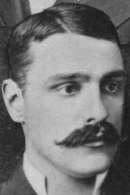Fred Goldsmith (baseball)
Fredrick Elroy Goldsmith (May 15, 1856 – March 28, 1939) was a right-handed pitcher in 19th-century professional baseball in both the U.S. and Canada. In his prime, Goldsmith was six-foot-one-inch tall and weighed 195 pounds.
| Fred Goldsmith | |||
|---|---|---|---|
 | |||
| Pitcher | |||
| Born: May 15, 1856 New Haven, Connecticut | |||
| Died: March 28, 1939 (aged 82) Berkley, Michigan | |||
| |||
| MLB debut | |||
| October 23, 1875, for the New Haven Elm Citys | |||
| Last MLB appearance | |||
| September 10, 1884, for the Baltimore Orioles | |||
| MLB statistics | |||
| Win–loss record | 112–68 | ||
| ERA | 2.73 | ||
| Complete games | 174 | ||
| Teams | |||
| |||
The Great Curveball Debate: Goldsmith or Cummings?
The two strongest candidates for inventing the curveball are Fred Goldsmith and Candy Cummings, Goldsmith's old rival when the two played in the International Association for Professional Base Ball Players in 1877–78—Goldsmith with the pennant-winning London Tecumsehs and Cummings with the Lynn, Massachusetts, Live Oaks. Cummings was also the first president of the International Association when he pitched for the Lynn Live Oaks.
While it is difficult, if not impossible, to pin down definitively who did first invent or throw the first curveball, the lore is that Candy Cummings threw the first known curveball during a game in 1867 in Worcester, Massachusetts, with the Brooklyn Excelsiors.
Fred Goldsmith is credited with giving the first publicly recorded demonstration of a curveball to sportswriter-baseball historian Henry Chadwick on August 16, 1870, at the Capitoline Grounds in Brooklyn, New York.[1]
Sportscaster-American actor Bill Stern waded into the debate in 1949 with a "favorite story" firmly crediting Goldsmith as the inventor and with transforming baseball. (See Bill Stern on the curveball.)
Additionally, an article in The London Free Press (Fred Goldsmith Invented The Curveball) of June 21, 1939, credits Goldsmith with inventing the curveball and says that "Just three days following Fred Goldsmith's death [on March 28, 1939], The Sporting News devoted an editorial to Goldsmith's feat of 61 years ago and asked that he be officially recognized as the inventor of the curve ball."
Further, an article in the August 2, 1938, London Free Press (Nick Altrock Is Here For Today) indicates that former Major League pitcher Nick Altrock also believed that Goldsmith invented the curveball. Altrock and Goldsmith were in London, Ontario, for an Old Boys Reunion and afternoon game at Labatt Park between a team from Battle Creek, Michigan, and a London Seniors team.
Ironically, Cummings was elected to the Baseball Hall of Fame in Cooperstown, New York in 1939—the same year that Goldsmith died—largely due to Cummings's supposed invention of the curveball.
Goldsmith's professional career
During his lifetime, Goldsmith pitched professionally for the New Haven New Havens (1875); the London Tecumsehs (in 1876, before the Tecumsehs joined the International Association) and after the Tecumsehs joined the fledgling International Association (1877–78); the Troy, New York Trojans of the National League (1879); the Chicago White Stockings of the National League (1880–1884) and briefly for the Baltimore Orioles of the American Association (1884).
Pitching for the Chicago White Stockings, Goldsmith had four seasons with 20 wins or more: 1880 (21–3); 1881 (24–13); 1882 (28–17); 1883 (25–19).
Goldsmith's win–loss percentage of .622 (112–68) does not include his games in New Haven or in London, Ontario, Canada, with the International Association pennant winners, the London Tecumsehs.
During Goldsmith's five-season stint pitching for the Chicago White Stockings, he played with first baseman Cap Anson and for team President A.G. Spalding, when Chicago won several league pennants. Goldsmith's final game in the pro ranks was on September 10, 1884.
Images of Fred Goldsmith
 1. London Tecumsehs Team – Fred Goldsmith (1st row, 2nd from left)
1. London Tecumsehs Team – Fred Goldsmith (1st row, 2nd from left)
(1876–1878) 2. Chicago White Stockings Team Photo – Fred Goldsmith (upper right)
2. Chicago White Stockings Team Photo – Fred Goldsmith (upper right)
(1880)
 3. Chicago White Stocking Team Photo – Fred Goldsmith (2nd row, 2nd from right)
3. Chicago White Stocking Team Photo – Fred Goldsmith (2nd row, 2nd from right)
(1882) 4. Fred Goldsmith Sketch from the Official Baseball Record which includes biography
4. Fred Goldsmith Sketch from the Official Baseball Record which includes biography
(1886) 5. Fred Goldsmith Photo from family archives.
5. Fred Goldsmith Photo from family archives.
(1920s) 6. Fred Goldsmith Photo of himself looking at the Chicago White Stockings team photo.
6. Fred Goldsmith Photo of himself looking at the Chicago White Stockings team photo.
(late 1930s)
References
- Brooklyn Eagle newspaper, August 17, 1870.
- Bill Stern's Favorite Baseball Stories by Bill Stern, (Blue Ribbon Books, Garden City, New York, 1949).
- Fred Goldsmith Invented The Curve Ball by Howard Broughton, Assistant Sports Editor, The London Free Press, June 21, 1939.
- Nick Altrock Is Here For Today by Howard Broughton, The London Free Press, August 2, 1938.
- Cheering for the Home Team: The Story of Baseball in Canada by William Humber, (The Boston Mills Press, 1983).
- Old Time Baseball and the London Tecumsehs of the late 1870s by Les Bronson, a recorded (and later transcribed) talk given to the London & Middlesex Historical Society on February 15, 1972. Available in the London Room of the London Public Library, Main Branch.
- Some Baseball History, Both Amateur and Professional, in the City of London, Synopsis of Tecumsehs, the Renowned Champions of Early Days by Frank Adams, for 58 years a member of The London Advertiser staff, pages 214–217 of The Canadian Science Digest, March, 1938, published monthly in London, Ontario, Canada, by Walter Venner.